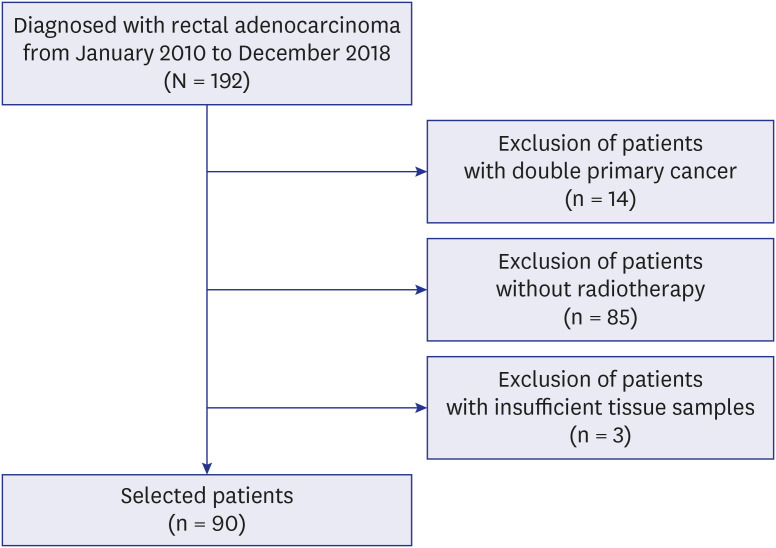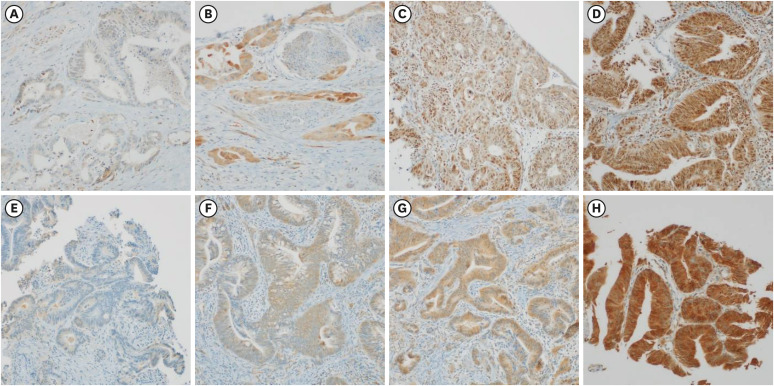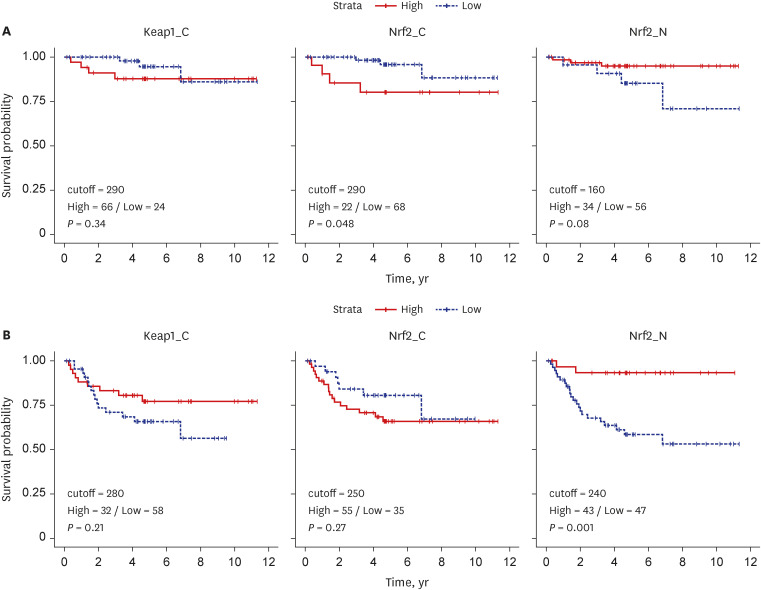J Korean Med Sci.
2023 Jul;38(26):e200. 10.3346/jkms.2023.38.e200.
Nuclear Factor Erythroid 2-Related Factor 2/Kelch-Like ECH-Associated Protein 1 as a Predictor of Prognosis and Radiotherapy Resistance in Patients With Locally Advanced Rectal Cancer: A Prospective Analysis
- Affiliations
-
- 1Department of Pathology, Keimyung University Dongsan Hospital, Daegu, Korea
- 2Department of Immunology, Keimyung University School of Medicine, Daegu, Korea
- 3Institute of Medical Science, Keimyung University, Daegu, Korea
- 4Institute for Cancer Research, Keimyung University, Daegu, Korea
- 5Department of Surgery, Keimyung University Dongsan Hospital, Daegu, Korea
- 6Department Radiation Oncology, Keimyung University School of Medicine, Daegu, Korea
- 7Department of Immunology, School of Medicine, Kyungpook National University, Daegu, Korea
- KMID: 2544015
- DOI: http://doi.org/10.3346/jkms.2023.38.e200
Abstract
- Background
The nuclear factor erythroid 2-related factor 2/Kelch-like ECH-associated protein 1 (Nrf2/Keap1) signaling pathway is involved in the regulation of cellular responses to oxidative stress. Nrf2 acts as a cell protector from inflammation, cellular damage, and tumorigenesis, whereas Keap1 is a negative regulator of Nrf2. Dysregulation of the Nrf2/ Keap1 pathway results in tumorigenesis and the active metabolism of tumor cells, leading to high resistance to radiotherapy. This study aimed to evaluate the predictive role of Nrf2 and Keap1 in the radiosensitivity and prognosis of locally advanced rectal cancer (LARC).
Methods
In total, 90 patients with LARC underwent surgery after preoperative chemoradiotherapy (CRT). Endoscopic biopsies from the tumors were obtained before radiation, and the Nrf2 and Keap1 expressions were assessed by immunohistochemistry. The response to therapy was evaluated after surgery following CRT according to the pathologic tumor regression grade. The disease-free survival (DFS) and overall survival rates were also documented. The association between the Nrf2 and Keap1 immunoreactivity and the clinicopathological parameters was analyzed.
Results
The overexpression of the nuclear Nrf2 before CRT showed a significant correlation with better DFS. The cytoplasmic Nrf2 expression was associated with more residual tumors after radiotherapy and a more unfavorable DFS, indicating lower radiosensitivity.
Conclusion
CRT is an important issue in LARC and is a major aspect of treatment. Thus, the Nrf2/Keap1 expression may be a potential predictor of preoperative therapeutic resistance. The Nrf2-Keap1 modulators that interact with each other may also be effectively applicable to CRT effect in LARC.
Keyword
Figure
Reference
-
1. Park EJ. Shifting treatment strategies to prevent early relapse of locally advanced rectal cancer after preoperative chemoradiotherapy. Ann Coloproctol. 2020; 36(6):357–358. PMID: 33486905.2. Baidoun F, Elshiwy K, Elkeraie Y, Merjaneh Z, Khoudari G, Sarmini MT, et al. Colorectal cancer epidemiology: recent trends and impact on outcomes. Curr Drug Targets. 2021; 22(9):998–1009. PMID: 33208072.3. Wang Y, Zhang J, Zhou M, Yang L, Wan J, Shen L, et al. Poor prognostic and staging value of tumor deposit in locally advanced rectal cancer with neoadjuvant chemoradiotherapy. Cancer Med. 2019; 8(4):1508–1520. PMID: 30790459.4. Suzuki T, Yamamoto M. Molecular basis of the Keap1-Nrf2 system. Free Radic Biol Med. 2015; 88(Pt B):93–100. PMID: 26117331.5. Taguchi K, Yamamoto M. The KEAP1-NRF2 system in cancer. Front Oncol. 2017; 7:85. PMID: 28523248.6. DeNicola GM, Karreth FA, Humpton TJ, Gopinathan A, Wei C, Frese K, et al. Oncogene-induced Nrf2 transcription promotes ROS detoxification and tumorigenesis. Nature. 2011; 475(7354):106–109. PMID: 21734707.7. Zimta AA, Cenariu D, Irimie A, Magdo L, Nabavi SM, Atanasov AG, et al. The role of Nrf2 activity in cancer development and progression. Cancers (Basel). 2019; 11(11):1755. PMID: 31717324.8. Zhang M, Zhang C, Zhang L, Yang Q, Zhou S, Wen Q, et al. Nrf2 is a potential prognostic marker and promotes proliferation and invasion in human hepatocellular carcinoma. BMC Cancer. 2015; 15(1):531. PMID: 26194347.9. Saw CL, Kong AN. Nuclear factor-erythroid 2-related factor 2 as a chemopreventive target in colorectal cancer. Expert Opin Ther Targets. 2011; 15(3):281–295. PMID: 21261563.10. Chen HY, Feng LL, Li M, Ju HQ, Ding Y, Lan M, et al. College of American Pathologists tumor regression grading system for long-term outcome in patients with locally advanced rectal cancer. Oncologist. 2021; 26(5):e780–e793. PMID: 33543577.11. Fedchenko N, Reifenrath J. Different approaches for interpretation and reporting of immunohistochemistry analysis results in the bone tissue - a review. Diagn Pathol. 2014; 9(1):221. PMID: 25432701.12. Hammad A, Namani A, Elshaer M, Wang XJ, Tang X. “NRF2 addiction” in lung cancer cells and its impact on cancer therapy. Cancer Lett. 2019; 467:40–49. PMID: 31574294.13. Jeong Y, Hoang NT, Lovejoy A, Stehr H, Newman AM, Gentles AJ, et al. Role of KEAP1/NRF2 and TP53 mutations in lung squamous cell carcinoma development and radiation resistance. Cancer Discov. 2017; 7(1):86–101. PMID: 27663899.14. Noh JK, Woo SR, Yun M, Lee MK, Kong M, Min S, et al. SOD2- and NRF2-associated gene signature to predict radioresistance in head and neck cancer. Cancer Genomics Proteomics. 2021; 18(5):675–684. PMID: 34479919.15. Chang H, Wei JW, Tao YL, Ding PR, Xia YF, Gao YH, et al. CCR6 is a predicting biomarker of radiosensitivity and potential target of radiosensitization in rectal cancer. Cancer Res Treat. 2018; 50(4):1203–1213. PMID: 29268566.16. Itoh K, Wakabayashi N, Katoh Y, Ishii T, Igarashi K, Engel JD, et al. Keap1 represses nuclear activation of antioxidant responsive elements by Nrf2 through binding to the amino-terminal Neh2 domain. Genes Dev. 1999; 13(1):76–86. PMID: 9887101.17. Lu MC, Ji JA, Jiang ZY, You QD. The Keap1-Nrf2-ARE pathway as a potential preventive and therapeutic target: an update. Med Res Rev. 2016; 36(5):924–963. PMID: 27192495.18. Ahtikoski AM, Kangas J, Salonen R, Puistola U, Karihtala P. Cytoplasmic Keap1 expression is associated with poor prognosis in endometrial cancer. Anticancer Res. 2019; 39(2):585–590. PMID: 30711933.19. Chen MJ, Lin PL, Wang L, Cheng YM, Chen CY, Lee H. Cytoplasmic, but not nuclear Nrf2 expression, is associated with inferior survival and relapse rate and response to platinum-based chemotherapy in non-small cell lung cancer. Thorac Cancer. 2020; 11(7):1904–1910. PMID: 32394538.
- Full Text Links
- Actions
-
Cited
- CITED
-
- Close
- Share
- Similar articles
-
- Kelch-like ECH-associated Protein 1/Nuclear Factor Erythroid 2-related Factor 2 Pathway and Its Interplay with Oncogenes in Lung Tumorigenesis
- High Expression of NRF2 and Low Expression of KEAP1 Predict Worse Survival in Patients With Operable Triple-Negative Breast Cancer
- Intraoperative Radiotherapy for Locally Advanced Rectal Cancer
- Nrf2, A Target for Precision Oncology in Cancer Prognosis and Treatment
- Multivisceral resection for locally advanced rectal cancer: adequate length of distal resection margin




